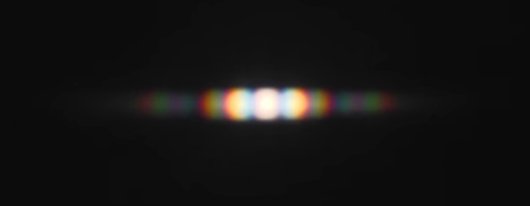Scientific controversies aren’t always settled by a single dramatic experiment, but it’s a lot of fun when they are. It’s even more fun when they can be carried out with, as the author put it, “without any other apparatus than is at hand to every one.”
I’m speaking in this case of the famous “double slit” experiment of Thomas Young, though if you want to be really picky about it, he didn’t originally do it with a double slit, but a single “slip of card” that divided a beam of sunlight. Some distance away from the card, the overlapping light from either side of the card combined to produce a pattern of multiple spots, and colored fringes.
How does this work? Well, you can find it lots of places (for example, here’s a decent textbook-y treatment), but I’m going to outsource the details to this really excellent Veritasium video:
Young’s experiment was an essential step toward the widespread acceptance of the wave theory of light. Prior to this, scientists had been arguing for about a hundred years between a particle theory of light, advocated by Isaac Newton, and a wave theory, advocated by Christiaan Huygens. Both pictures could be used to make useful predictions about some optical phenomena, but Young’s experiment really only works if light has wave nature.
(Of course, if you really want to get picky, the truly decisive experiment was about a decade later, when Augustin-Jean Fresnel proposed a wave model of light, and Siméon Poisson pointed out that waves passing around an opaque circular object ought to produce a bright spot at the center of the dark shadow, which he felt was clearly absurd. Right up until Dominique-François-Jean Arago did the experiment, and demonstrated that there is, in fact, a bright spot at the center of the shadow of a round object. That really sealed the case for the wave theory, for about a hundred years, anyway…)
Young’s experiment is important not just because of what it says about light, but because it established the idea of interference and diffraction as the essential wave phenomena. In the late 1920’s, the observation of interference phenomena with beams of electrons (about which more later) was an essential step in the development of quantum mechanics.
Young’s idea is also important because it provides a way to convert the extremely tiny wavelength of light– about 0.0000005m for visible light, give or take a bit– into distances that can be readily measured with more conventional techniques. If you know the thickness of the slip of paper dividing the beam, and measure the spacing between spots of the resulting pattern (which can be made as big as you like), you can accurately measure the wavelength of light. And you can turn that around, and use a known wavelength to measure an unknown thickness with high precision. Interference phenomena are essential to most modern precision measurement techniques.
So, all in all, a pretty impressive achievement from a single slip of card.
————
(Part of a series promoting Eureka: Discovering Your Inner Scientist, available from Amazon, Barnes and Noble, IndieBound, Powell’s, and anywhere else books are sold.)
(The quote is from Young’s report to the Royal Society about his experiments, which you can read for free online.)
